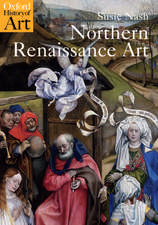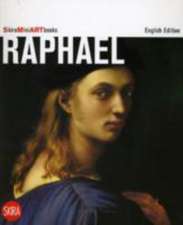Titian, Colonna and the Renaissance Science of Procreation: Equicola's Seasons of Desire: Visual Culture in Early Modernity
Autor Anthony Colantuonoen Limba Engleză Paperback – 30 noi 2016
| Toate formatele și edițiile | Preț | Express |
|---|---|---|
| Paperback (1) | 343.55 lei 6-8 săpt. | |
| Taylor & Francis – 30 noi 2016 | 343.55 lei 6-8 săpt. | |
| Hardback (1) | 819.90 lei 6-8 săpt. | |
| Taylor & Francis – sep 2010 | 819.90 lei 6-8 săpt. |
Din seria Visual Culture in Early Modernity
-
 Preț: 311.06 lei
Preț: 311.06 lei -
 Preț: 312.12 lei
Preț: 312.12 lei -
 Preț: 341.55 lei
Preț: 341.55 lei - 22%
 Preț: 324.16 lei
Preț: 324.16 lei -
 Preț: 312.00 lei
Preț: 312.00 lei -
 Preț: 310.51 lei
Preț: 310.51 lei - 18%
 Preț: 901.74 lei
Preț: 901.74 lei -
 Preț: 313.67 lei
Preț: 313.67 lei -
 Preț: 406.98 lei
Preț: 406.98 lei - 13%
 Preț: 338.33 lei
Preț: 338.33 lei - 17%
 Preț: 259.98 lei
Preț: 259.98 lei -
 Preț: 471.08 lei
Preț: 471.08 lei - 22%
 Preț: 324.16 lei
Preț: 324.16 lei - 22%
 Preț: 324.16 lei
Preț: 324.16 lei - 25%
 Preț: 769.92 lei
Preț: 769.92 lei - 25%
 Preț: 826.84 lei
Preț: 826.84 lei - 26%
 Preț: 819.90 lei
Preț: 819.90 lei - 9%
 Preț: 949.21 lei
Preț: 949.21 lei - 25%
 Preț: 829.69 lei
Preț: 829.69 lei - 22%
 Preț: 325.43 lei
Preț: 325.43 lei - 25%
 Preț: 824.40 lei
Preț: 824.40 lei - 13%
 Preț: 338.33 lei
Preț: 338.33 lei - 25%
 Preț: 826.01 lei
Preț: 826.01 lei - 25%
 Preț: 772.60 lei
Preț: 772.60 lei - 18%
 Preț: 1017.63 lei
Preț: 1017.63 lei - 25%
 Preț: 768.69 lei
Preț: 768.69 lei - 13%
 Preț: 338.33 lei
Preț: 338.33 lei - 25%
 Preț: 771.13 lei
Preț: 771.13 lei - 22%
 Preț: 324.16 lei
Preț: 324.16 lei - 25%
 Preț: 772.76 lei
Preț: 772.76 lei - 11%
 Preț: 347.33 lei
Preț: 347.33 lei - 25%
 Preț: 882.90 lei
Preț: 882.90 lei - 26%
 Preț: 765.84 lei
Preț: 765.84 lei -
 Preț: 489.26 lei
Preț: 489.26 lei - 13%
 Preț: 338.33 lei
Preț: 338.33 lei - 25%
 Preț: 853.03 lei
Preț: 853.03 lei - 25%
 Preț: 822.91 lei
Preț: 822.91 lei - 12%
 Preț: 300.09 lei
Preț: 300.09 lei - 26%
 Preț: 820.73 lei
Preț: 820.73 lei - 25%
 Preț: 829.69 lei
Preț: 829.69 lei
Preț: 343.55 lei
Preț vechi: 389.41 lei
-12% Nou
Puncte Express: 515
Preț estimativ în valută:
65.74€ • 68.22$ • 54.95£
65.74€ • 68.22$ • 54.95£
Carte tipărită la comandă
Livrare economică 17-31 martie
Preluare comenzi: 021 569.72.76
Specificații
ISBN-13: 9781138274709
ISBN-10: 1138274704
Pagini: 344
Dimensiuni: 174 x 246 mm
Greutate: 0.7 kg
Ediția:1
Editura: Taylor & Francis
Colecția Routledge
Seria Visual Culture in Early Modernity
Locul publicării:Oxford, United Kingdom
ISBN-10: 1138274704
Pagini: 344
Dimensiuni: 174 x 246 mm
Greutate: 0.7 kg
Ediția:1
Editura: Taylor & Francis
Colecția Routledge
Seria Visual Culture in Early Modernity
Locul publicării:Oxford, United Kingdom
Cuprins
Contents: Preface; Introduction; Part 1 Alfonso d'Este's Camerino, Mario Equicola and the Libidinal Seasons: Proemium: The libido in winter: Bellini's Feast of the Gods; The libido in spring: Titian's Bacchus and Ariadne; The libido in summer: Titian's Bacchanal of the Andrians; The libido in Autumn: Titian's Feast of Venus; Interpreting the camerino: the bacchanals as procreative pedagogy. Part 2 Colonna's Poliphilus - the Science and Season of Sexual Performance: Proemium: Duke Guidubaldo's dysfunction: Poliphilus and the diagnosis of love; Poliphilus's nightmare and erotic magic: an excursus on the bewitching of the male genitalia; Poliphilus's wet dream; A Venus in the bedroom; Coloring the roses: Colonna, Titan and the '3rd Venus'; A sacred/profane love: the Dodonian font and Poliphilus's wedding; Conclusion; Bibliography; Index.
Notă biografică
Anthony Colantuono is Associate Professor of Art History at the University of Maryland - College Park, USA
Recenzii
Rated as 'Research Essential' by Baker & Taylor
'This book sets a new standard for the analysis of Renaissance texts and for iconographic studies in art history. Rehearsing in compelling detail the process through which mytho-poetic inventions were conceived in Italy for courtly cabinet-paintings, Colantuono presents a fascinating re-reading of Bellini‘s and Titian‘s famous bacchanals, painted for Alfonso d Este in the early sixteenth century. Informed by a neo-Aristotelian discourse on the natural (seasonal) causes of sexual desire, these paintings, we now understand, served to instruct the knowledgeable viewer on the healthful and productive management of the male libido, so important to the dynastic endurance of the d Este and other Italian elites who constituted the paintings' viewing audience. Deftly combining erudite intellectual history with a situated excursus on the snares of libidinal desire and the efficacy of managing sex, this book presents a cogent interpretation of famously enigmatic pictorial texts and is a must read across the disciplines in early modern studies, offering a paradigmatic analysis of the production and reception of Renaissance art.' Karen-edis Barzman, Binghamton University, USA
'Any good book starts with a good question. In this case it‘s a puzzle, involving a pseudo-Aristotelian text on the nature of the human libido, a series of celebrated Renaissance paintings and a riddle: how did Aristotle‘s theories of procreation make it into Titian‘s paintings and Colonna‘s masterpiece? This book reads like a mystery with a philosophical, indeed Aristotelian, denouement. At one point I couldn't put it down... An extraordinary example of scholarship.' Cristina Perissinotto, University of Ottawa, Canada
'In Titian, Colonna and the Renaissance Science of Procreation: Equicola's Seasons of Desire, Anthony Colantuono examines erotic images of seminal importance to Renaissance iconography and sensibility. His i
'This book sets a new standard for the analysis of Renaissance texts and for iconographic studies in art history. Rehearsing in compelling detail the process through which mytho-poetic inventions were conceived in Italy for courtly cabinet-paintings, Colantuono presents a fascinating re-reading of Bellini‘s and Titian‘s famous bacchanals, painted for Alfonso d Este in the early sixteenth century. Informed by a neo-Aristotelian discourse on the natural (seasonal) causes of sexual desire, these paintings, we now understand, served to instruct the knowledgeable viewer on the healthful and productive management of the male libido, so important to the dynastic endurance of the d Este and other Italian elites who constituted the paintings' viewing audience. Deftly combining erudite intellectual history with a situated excursus on the snares of libidinal desire and the efficacy of managing sex, this book presents a cogent interpretation of famously enigmatic pictorial texts and is a must read across the disciplines in early modern studies, offering a paradigmatic analysis of the production and reception of Renaissance art.' Karen-edis Barzman, Binghamton University, USA
'Any good book starts with a good question. In this case it‘s a puzzle, involving a pseudo-Aristotelian text on the nature of the human libido, a series of celebrated Renaissance paintings and a riddle: how did Aristotle‘s theories of procreation make it into Titian‘s paintings and Colonna‘s masterpiece? This book reads like a mystery with a philosophical, indeed Aristotelian, denouement. At one point I couldn't put it down... An extraordinary example of scholarship.' Cristina Perissinotto, University of Ottawa, Canada
'In Titian, Colonna and the Renaissance Science of Procreation: Equicola's Seasons of Desire, Anthony Colantuono examines erotic images of seminal importance to Renaissance iconography and sensibility. His i
Descriere
Two major monuments of Italian Renaissance culture-Bellini's and Titian's famous series of mytho-poetical "bacchanal" paintings, and Francesco Colonna's Hypnerotomachia Poliphili -are here shown to have been conceived as mnemonic or pedagogical devices aimed at educating the reader/beholder in the medical science of reproductive physiology and the maintenance of sexual health. This study clarifies the historical relationship between the pictorial and literary works and explains their larger cultural significance.








